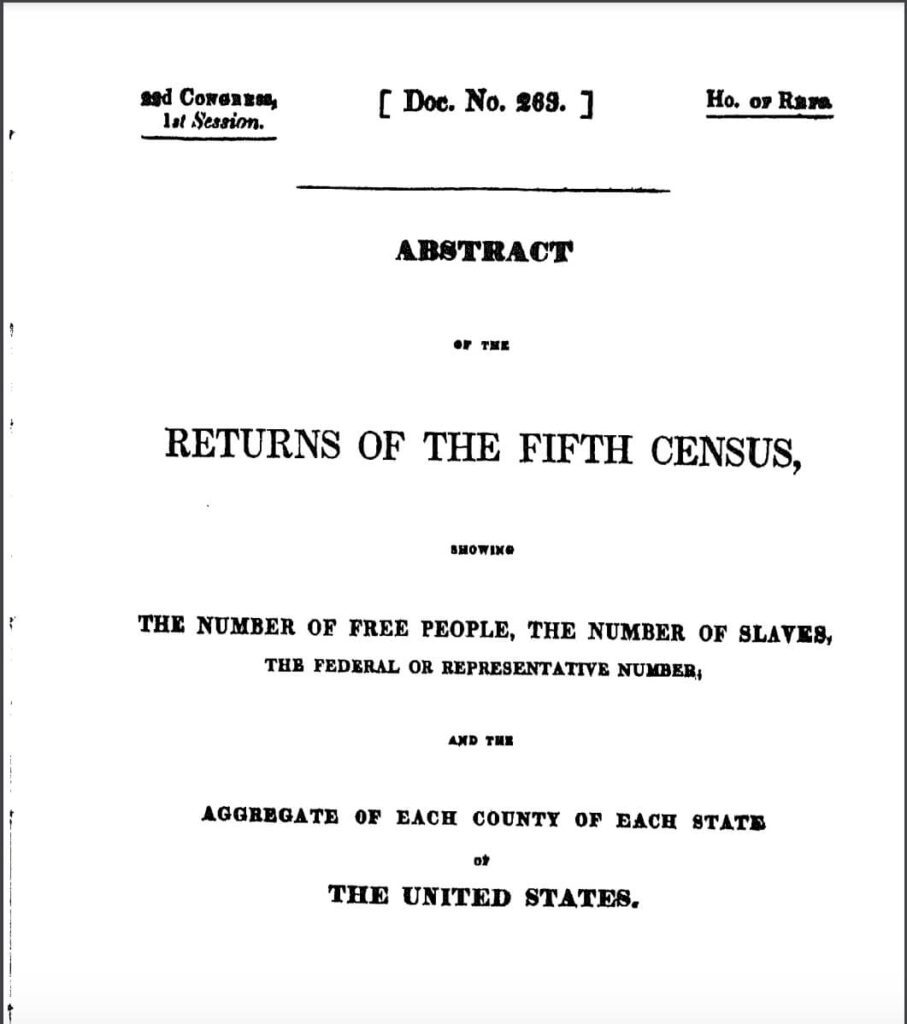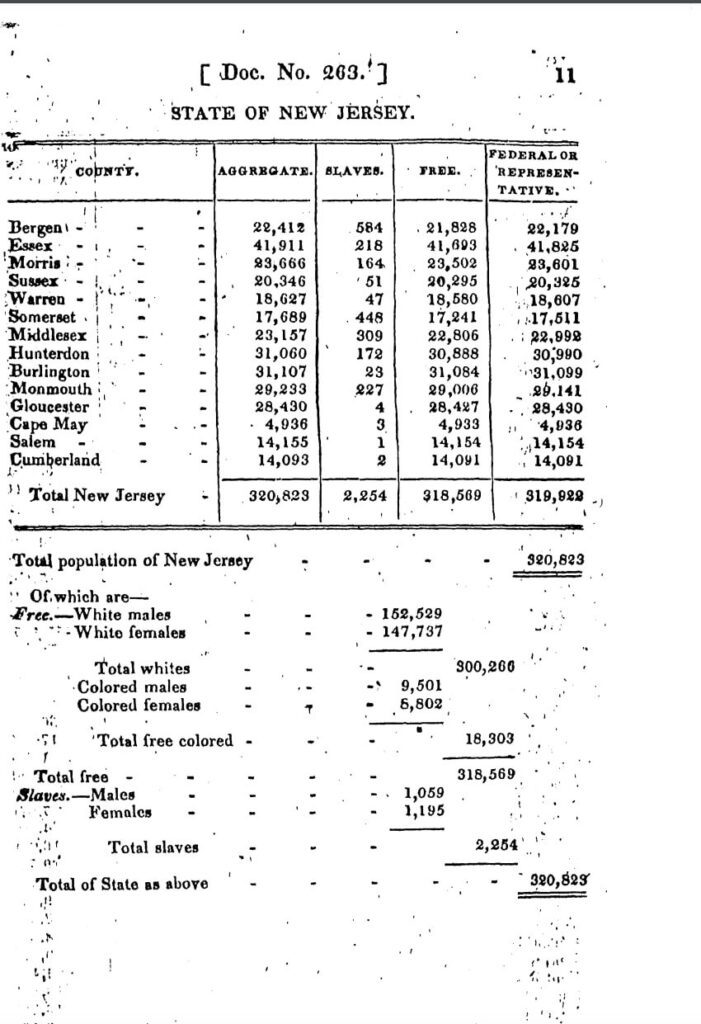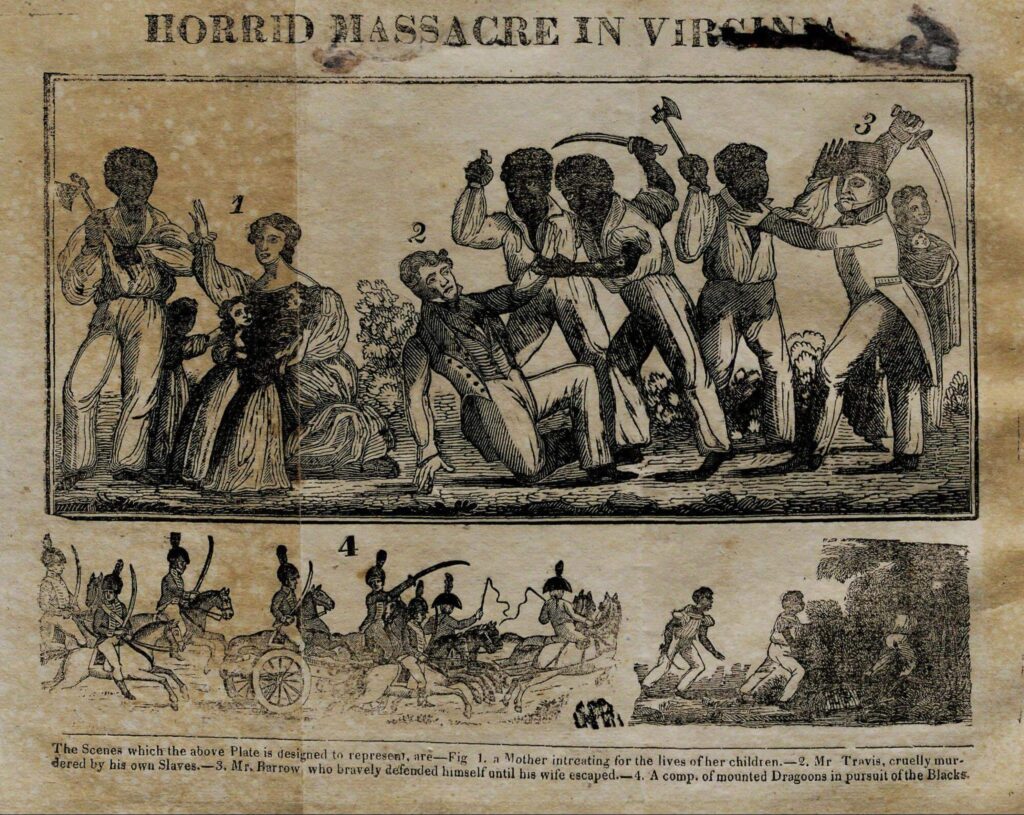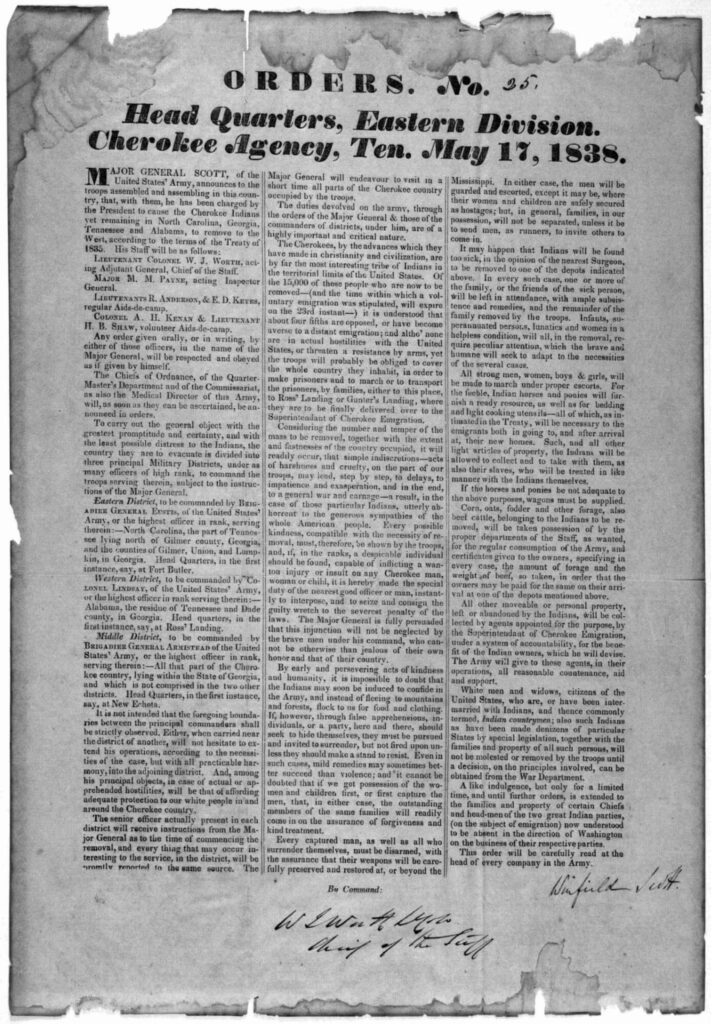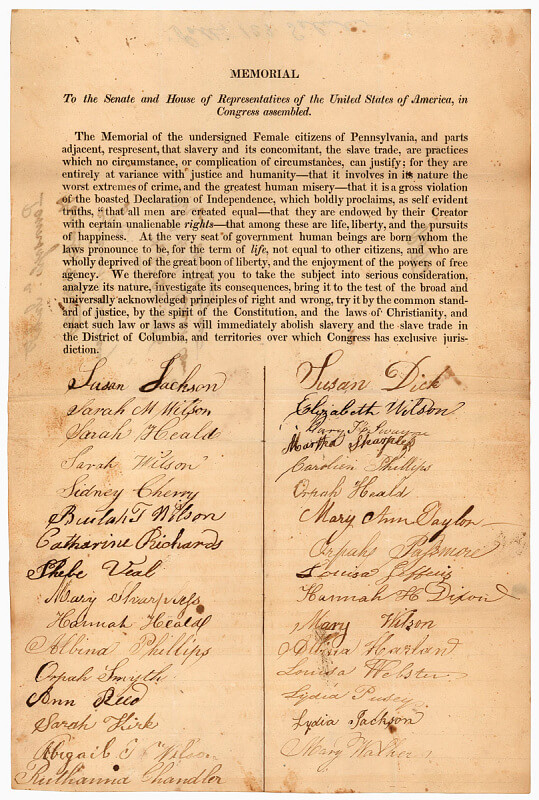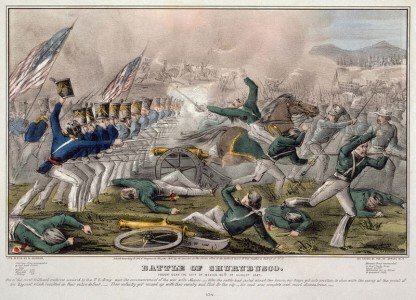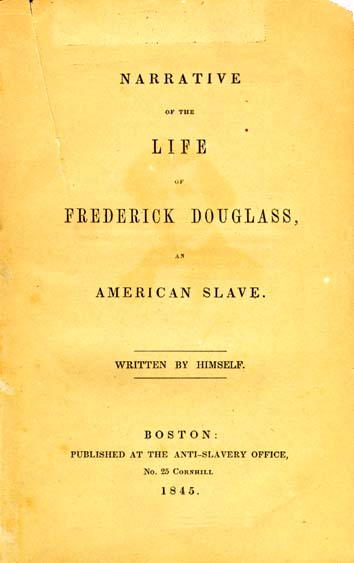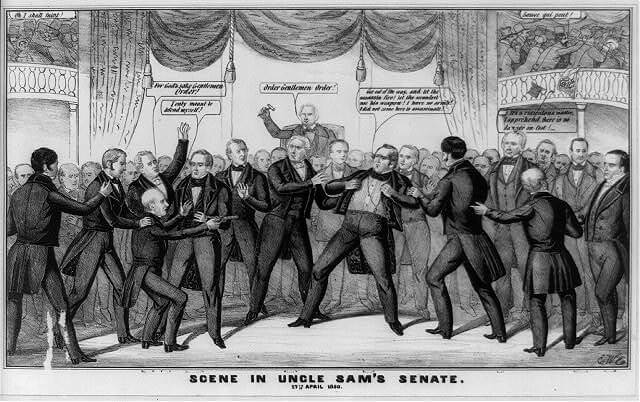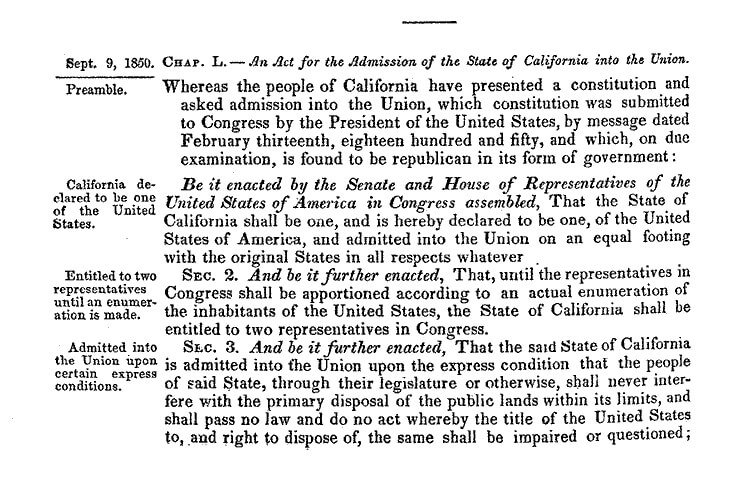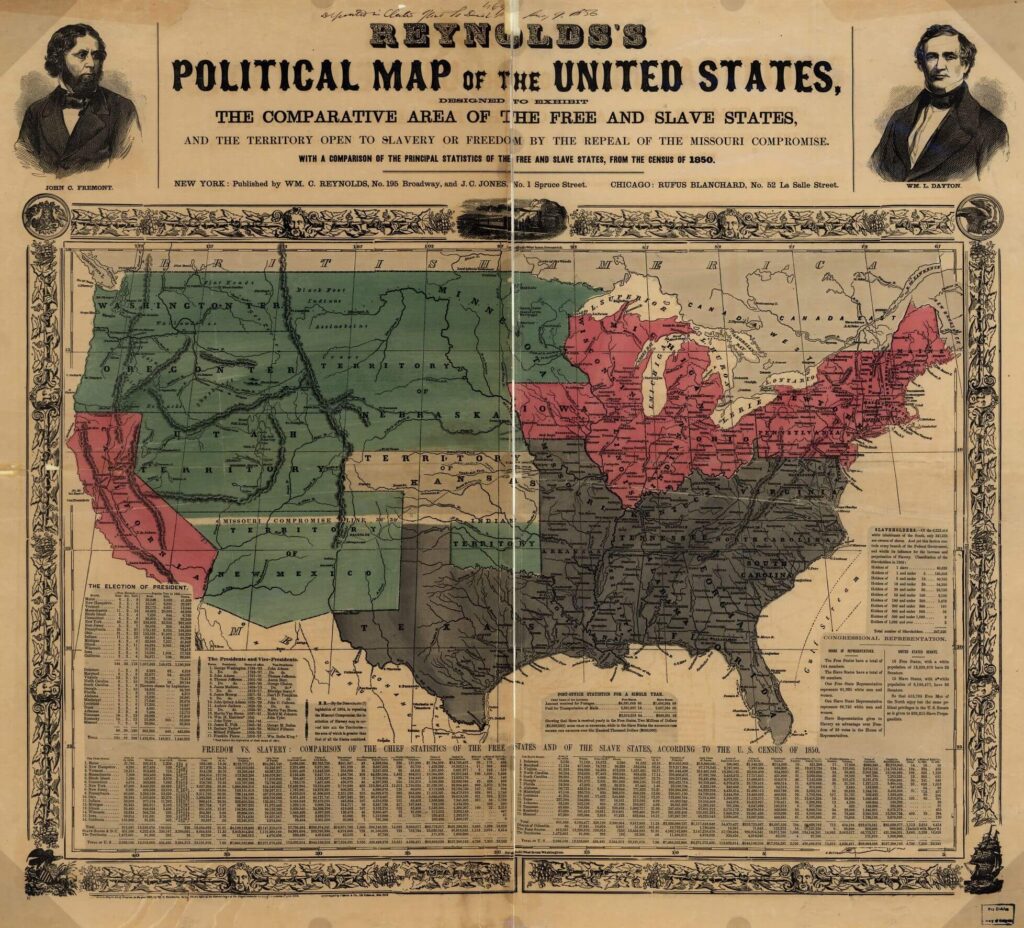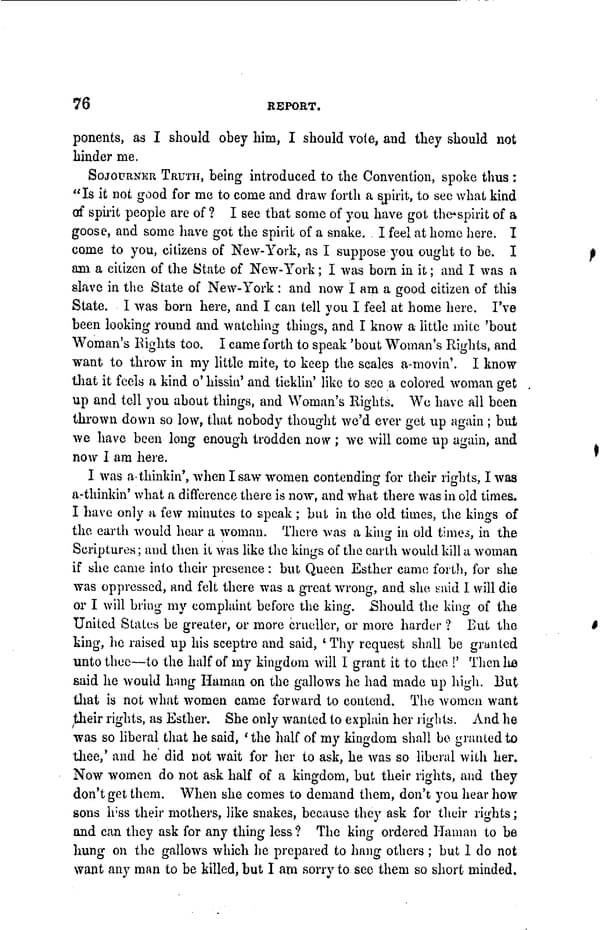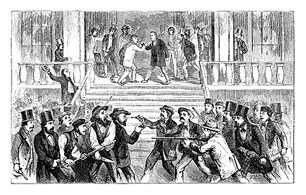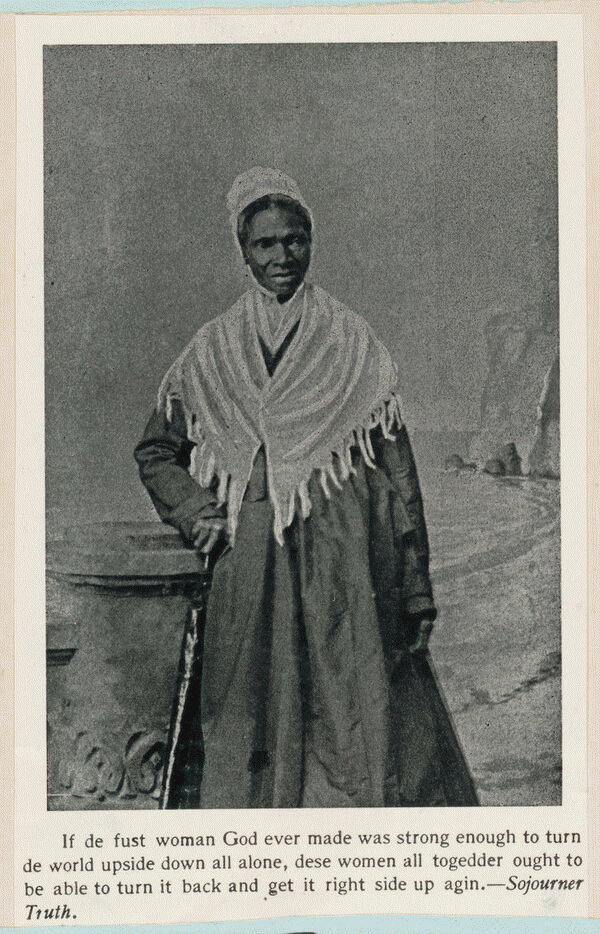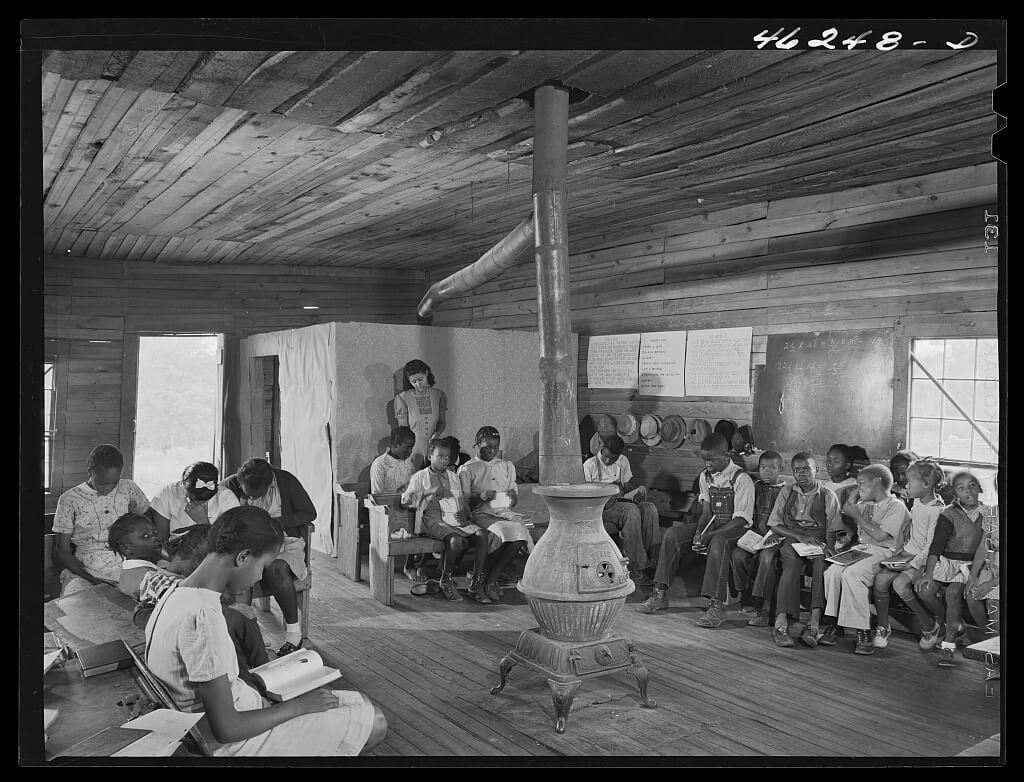The curated resources linked below are an initial sample of the resources coming from a collaborative and rigorous review process with the EAD Content Curation Task Force.
 Reset All
Reset All
The phrase “a house divided” comes from Abraham Lincoln’s speech to the Illinois Republican State Convention in 1858, when he describes a nation so badly torn between those that permitted slavery and those that prohibited it that it was on the brink of war. While the issue of slavery is understood to be central to the start of the Civil War, this set of resources is intended to introduce students to more details of the growing tension in the nation. Resources include information and images about expanding territory and the addition of new states to the union; voices of the abolitionist movement; political tension and acts of violence. It does not provide comprehensive coverage of these decades, but it helps to highlight that the growing tension was both multifaceted and happening across the entire nation.
The resources in this spotlight kit are intended for classroom use, and are shared here under a CC-BY-SA license. Teachers, please review the copyright and fair use guidelines.


The Roadmap














- Primary Resources by Decade1830s (4)1840s (3)1850s (9)
- All 16 Primary ResourcesThe Census of 1830
This abstract of the Census from 1830 not only provides numbers, state by state, of free and enslaved persons – but students will note that there are enslaved persons in many of the states they consider “free” (sample pages at left).
Note that the terminology is historically accurate but might be offensive to students unless context is provided (this will be true for many of the documents from this era).
CitePrintSharehttps://www2.census.gov/library/publications/decennial/1830/1830b.pdf
ORIIN, DUFF. “1830 Census - Full Document.” Census.gov, https://www2.census.gov/library/publications/decennial/1830/1830b.pdf.
Nat Turner’s Rebellion, 1831Transcript“Even though Turner and his followers had been stopped, panic spread across the region. In the days following the attack, 3000 soldiers, militia men, and vigilantes killed more than one hundred suspected rebels. …Nat Turner’s rebellion led to the passage of a series of new laws. The Virginia legislature actually debated ending slavery, but chose instead to impose additional restrictions and harsher penalties on the activities of both enslaved and free African Americans. Other slave states followed suit, restricting the rights of free and enslaved blacks to gather in groups, travel, preach, and learn to read and write.” (Gilder Lehrman, link at right.)
Nat Turner’s Rebellion led to both public debate and a tightening of laws and policies. “Nat Turner was an enslaved man who had learned to read and write and become a religious leader despite his enslavement; following what he took to be religious signs, he led other enslaved people in an armed uprising. The violence of the uprising and Turner’s ability to escape and hide for approximately six weeks following the event led to changes in laws and policies and also led to a widespread climate of fear among white slaveholders. Enslaved people in far-flung states who had no connection to the event were lynched by white mobs. The State of Virginia briefly considered ending the practice of slavery in the wake of the rebellion, but they ultimately decided instead to tighten the laws of slavery.
1Africans in America/Part 3/Nat Turner's Rebellion. (n.d.). PBS. Retrieved March 20, 2022, from https://www.pbs.org/wgbh/aia/part3/3p1518.html and Nat Turner - Rebellion, Death & Facts - HISTORY. (2021, January 26). History.com. Retrieved March 20, 2022, from https://www.history.com/topics/black-history/nat-turnerCitePrintShareAllyn, Nelson. “Nat Turner's Rebellion, 1831 | Gilder Lehrman Institute of American History.” Gilder Lehrman Institute of American History |, https://www.gilderlehrman.org/history-resources/spotlight-primary-source/nat-turner%E2%80%99s-rebellion-1831.
Orders pursuant to the Indian Removal Act of 1830 (Trail of Tears)Orders pursuant to the Indian Removal Act of 1830 (Trail of Tears)While the Trail of Tears and “Indian Removal Act” are not central to understanding slavery, they are critical events in the history of the country in this era; in addition, the concept of “indian removal” connects directly to tensions that rose as the nation expanded in both population and territory.
As the United States acquired Western territories, and as the power battle between slaveholding and free states continued, the land on which Native nations lived became increasingly valuable. After President Andrew Jackson signed the Indian Removal Act of 1830, the Choctaw, Creek, and Cherokee nations were forced to move from their land, most often on foot and with the deaths of many people, into Western territories. The 1838 forced removal of the Cherokee people from their Georgia land led to the deaths of thousands of people (exact numbers are unknown, but estimates range around 4,000 - 5,000.)
1- History & Culture - Trail Of Tears National Historic Trail (US National Park Service). (2020, July 10). National Park Service. Retrieved March 20, 2022, from https://www.nps.gov/trte/learn/historyculture/index.htm and Trail of Tears: Indian Removal Act, Facts & Significance - HISTORY. (2020, July 7). History.com. Retrieved March 20, 2022, from https://www.history.com/topics/native-american-history/trail-of-tears
CitePrintShare“Tile.loc.gov.” Library of Congress, https://tile.loc.gov/storage-services/service/rbc/rbpe/rbpe17/rbpe174/1740400a/1740400a.pdf.
The Gag Rule, 1836“On May 26, 1836, the House of Representatives adopted a ‘Gag Rule’ stating that all petitions regarding slavery would be tabled without being read, referred, or printed….The enactment of the Gag Rule, rather than discouraging petitioners, energized the anti-slavery movement to flood the Capitol with written demands. Activists held up the suppression of debate as an example of the slaveholding South’s infringement of the rights of all Americans.”
CitePrintShareAdams, John Quincy. “The Gag Rule | National Museum of American History.” National Museum of American History, https://americanhistory.si.edu/democracy-exhibition/beyond-ballot/petitioning/gag-rule.
Map of Westward Expedition and Expansion, 1842-44Map of an exploring expedition to the Rocky Mountains in the year 1842 and to Oregon & north California in the years 1843-44As the nation expanded Westward, tensions rose further over whether new states and territories would permit or prohibit slavery.
CitePrintShareMap of an Exploring Expedition to the Rocky ... - Library of Congress. https://www.loc.gov/resource/g4051s.ct000909/.
Battlefield Painting, Mexican-American WarBattlefield Painting, Mexican-American War“The pact set a border between Texas and Mexico and ceded California, Nevada, Utah, New Mexico, most of Arizona and Colorado, and parts of Oklahoma, Kansas, and Wyoming to the United States. …the acquisition of so much territory with the issue of slavery unresolved lit the fuse that eventually set off the Civil War in 1861.”
CitePrintShare“The Mexican-American war in a nutshell.” National Constitution Center, 13 May 2021, https://constitutioncenter.org/blog/the-mexican-american-war-in-a-nutshell.
Narrative of the Life of Frederick Douglass, excerpt, 1845TranscriptCHAPTER I. I WAS born in Tuckahoe, near Hillsborough, and about twelve miles from Easton, in Talbot county, Maryland. I have no accurate knowledge of my age, never having seen any authentic record containing it. By far the larger part of the slaves know as little of their ages as horses know of theirs, and it is the wish of most masters within my knowledge to keep their slaves thus ignorant. I do not remember to have ever met a slave who could tell of his birthday. They seldom come nearer to it than planting-time, harvest-time, cherry-time, spring-time, or fall-time. A want of information concerning my own was a source of unhappiness to me even during childhood. The white children could tell their ages. I could not tell why I ought to be deprived of the same privilege. I was not allowed to make any inquiries of my master concerning it. He deemed all such inquiries on the part of a slave improper and impertinent, and evidence of a restless spirit. The nearest estimate I can give makes me now between twenty-seven and twenty-eight years of age. I come to this, from hearing my master say, some time during 1835, I was about seventeen years old.
Students would benefit from reading an excerpt of the text of Narrative of the Life of Frederick Douglass – but in addition, the cover itself is an interesting artifact, and students can discuss its details and its possible impact upon publication in 1845. (See also text in this chart, below, from Frederick Douglass’ July 4 address in 1852.)
CitePrintShareHempel, Carlene, et al. “Frederick Douglass, 1818-1895. Narrative of the Life of Frederick Douglass, an American Slave. Written by Himself.” Documenting the American South, https://docsouth.unc.edu/neh/douglass/douglass.html.
Scene in Uncle Sam’s Senate, 1850“Scene in Uncle Sam's Senate.Transcript"A somewhat tongue-in-cheek dramatization of the moment during the heated debate in the Senate over the admission of California as a free state when Mississippi senator Henry S. Foote drew a pistol on Thomas Hart Benton of Missouri.”
As new states were added to the nation, the question of how many would permit slavery and how many would prohibit it – and, therefore, which faction had more power – continued to contribute to growing tension.
CitePrintShare“Scene in Uncle Sam's Senate. 17th April 1850.” The Library of Congress, https://www.loc.gov/item/2008661528/.
An Act for the Admission of the State of California into the Union, 1850CitePrintShareA Century of Lawmaking for a New Nation: U.S. Congressional Documents and Debates, 1774 - 1875, https://memory.loc.gov/cgi-bin/ampage?collId=llsl&fileName=009%2Fllsl009.db&recNum=479.
Political Map of the United States in 1850Political map of the United States in 1850This map has a range of valuable information, not only about Presidential politics, but also about population statistics and slavery. It makes a particular point of comparison with the 1830 Census, hyperlinked above in this chart.
CitePrintShare“1850 Political Map of the United States - History.” U.S. Census Bureau, 9 December 2021, https://www.census.gov/history/www/reference/maps/1850_political_map_of_the_united_states.html.
Frederick Douglass, “What to the Slave is the Fourth of July?”, 1852Douglass raises critical questions about patriotism, citizenship, and the nation’s ideals in this address. The text highlights issues that will continue to be points of tension not only at the start of the Civil War, but throughout Reconstruction (and, truly, throughout American history).
“I say it with a sad sense of the disparity between us. I am not included within the pale of glorious anniversary! Your high independence only reveals the immeasurable distance between us. The blessings in which you, this day, rejoice, are not enjoyed in common. The rich inheritance of justice, liberty, prosperity and independence, bequeathed by your fathers, is shared by you, not by me. The sunlight that brought light and healing to you, has brought stripes and death to me. This Fourth July is yours, not mine. You may rejoice, I must mourn.”
- Frederick Douglass, July 5, 1852CitePrintShareJuly 5, 1852, Frederick Douglass keynote address at an Independence Day celebration: “What to the Slave is the Fourth of July?”
“A Nation's Story: “What to the Slave is the Fourth of July?”” National Museum of African American History and Culture, 3 July 2018, https://nmaahc.si.edu/explore/stories/nations-story-what-slave-fourth-july.
Sojourner Truth, Photograph and Speech at the Women’s Rights Convention, 1853See above; understanding the life and words of Sojourner Truth helps students to understand the complexity and intersectionality of both the women’s rights movement and the abolitionist movement.
CitePrintShareTitle Proceedings of the Woman's Rights Convention held at the Broadway Tabernacle, in the city of New York, on Tuesday and Wednesday, Sept. 6th and 7th, 1853.
Summary Sojourner Truth addresses the convention.
Image 76 of Susan B. Anthony Collection Copy | Library of Congress. https://www.loc.gov/resource/rbnawsa.n8289/?sp=76.
“Bleeding Kansas,” 1858“The years of 1854-1861 were a turbulent time in Kansas territory. The Kansas-Nebraska Act of 1854 …allowed the residents of these territories to decide by popular vote whether their state would be free or slave. This concept of self-determination was called popular sovereignty'. …Three distinct political groups occupied Kansas: pro-slavers, free-staters and abolitionists. Violence broke out immediately between these opposing factions and continued until 1861 when Kansas entered the Union as a free state on January 29th. This era became forever known as ‘Bleeding Kansas’.” (National Park Service, link at right.)
CitePrintShare“Bleeding Kansas - Fort Scott National Historic Site (US National Park Service).” National Park Service, 23 April 2020, https://www.nps.gov/fosc/learn/historyculture/bleeding.htm.
Abraham Lincoln, “A House Divided” Speech, 1858This excerpt from (or the entirety of) Lincoln’s address to the Republican State Convention puts the notion of “a house divided” in its original context, just before the start of the Civil War.
NOTE: Because it provides the central concept of this set of resources, I’ve included it last (although it predates John Brown’s speech above.)
Illinois Republican State Convention, Springfield, Illinois June 16, 1858Abraham Lincoln
Mr. President and Gentlemen of the Convention. If we could first know where we are, and whither we are tending, we could better judge what to do, and how to do it.
We are now far into the fifth year, since a policy was initiated, with the avowed object, and confident promise, of putting an end to slavery agitation. Under the operation of that policy, that agitation has not only, not ceased, but has constantly augmented.
In my opinion, it will not cease, until a crisis shall have been reached, and passed -
"A house divided against itself cannot stand."
I believe this government cannot endure, permanently half slave and half free.
I do not expect the Union to be dissolved - I do not expect the house to fall - but I do expect it will cease to be divided. It will become all one thing, or all the other.
1- John Brown's Raid (US National Park Service). (2021, July 30). National Park Service. Retrieved March 20, 2022, from https://www.nps.gov/articles/john-browns-raid.htm
- John Brown's Raid on Harper's Ferry. (n.d.). Ohio History Central. Retrieved March 20, 2022, from https://ohiohistorycentral.org/w/John_Brown%27s_Raid_on_Harper%27s_Ferry
CitePrintShare“House Divided Speech - Lincoln Home National Historic Site (US National Park Service).” National Park Service, 10 April 2015, https://www.nps.gov/liho/learn/historyculture/housedivided.htm.
An excerpt from John Brown's address to the court after hearing his guilty verdict, 1859John Brown’s raid on Harper’s Ferry fits into Lincoln’s foretelling of a crisis and further spurs the start of the Civil War. Brown’s speech to the courtroom highlights his sense of what, in this moment, constitutes justice and injustice.
John Brown’s Raid on Harper’s Ferry: John Brown, an abolitionist, led the Raid on Harper’s Ferry, a federal arsenal, in an effort to start an armed insurrection against slavery. The event, which took place after Lincoln’s “a house divided” speech, serves as an example of the violence Lincoln foretold. Brown echoed Lincoln’s sentiments, explaining in 1859, “I, John Brown, am now quite certain that the crimes of this guilty land will never be purged away but with blood. I had, as I now think, vainly flattered myself that without very much bloodshed it might be done.” Brown and his followers were trapped and arrested, and Brown was tried and found guilty of treason.
“I have, may it please the court, a few words to say. In the first place, I deny everything but what I have all along admitted--the design on my part to free the slaves. I intended certainly to have made a clean thing of that matter, as I did last winter when I went into Missouri and there took slaves without the snapping of a gun on either side, moved them through the country, and finally left them in Canada. I designed to have done the same thing again on a larger scale. That was all I intended. I never did intend murder, or treason, or the destruction of property, or to excite or incite slaves to rebellion, or to make insurrection.I have another objection; and that is, it is unjust that I should suffer such a penalty. Had I interfered in the manner which I admit...had I so interfered in behalf of the rich, the powerful, the intelligent, the so-called great, or in behalf of any of their friends--either father, mother, brother, sister, wife, or children, or any of that class--and suffered and sacrificed what I have in this interference, it would have been all right; and every man in this court would have deemed it an act worthy of reward rather than punishment.”
CitePrintShare“An excerpt from John Brown's address to the court after hearing his guilty verdict, 1859.” Digital Public Library of America, https://dp.la/primary-source-sets/john-brown-s-raid-on-harper-s-ferry/sources/1722.
The Women’s Rights Convention of 1853TranscriptQuotation beneath the photograph: "If de fust woman God ever made was strong enough to turn de world upside down all alone, dese women all togedder ought to be able to turn it back and get it right side up agin."
This photograph pairs with the text in the row below from the Women’s Rights Convention of 1853, when Sojourner Truth spoke to the group.
The Women’s Rights Convention: The Seneca Falls Convention of 1848 is a significant event in the fight for women’s rights and for women’s suffrage, though activists at the convention itself debated whether suffrage should be the center point of their platform. In addition, the Seneca Falls Convention is now widely understood to represent some tension between the women’s rights movement and the abolitionist movement; some activists at the time felt that the right to vote should not go to black men before white women. In this collection of documents, Sojourner Truth’s speech to a smaller, subsequent convention – one held in New York in 1853 – is included, largely because of the critical role Sojourner Truth plays in demonstrating the importance of the intersectionality of both the women’s rights and abolitionist movements.
1- On this day, the Seneca Falls Convention begins. (2021, July 19). National Constitution Center. Retrieved March 20, 2022, from https://constitutioncenter.org/blog/on-this-day-the-seneca-falls-convention-begins and More Women's Rights Conventions - Women's Rights National Historical Park (US National Park Service). (n.d.). National Park Service. Retrieved March 20, 2022, from https://www.nps.gov/wori/learn/historyculture/more-womens-rights-conventions.htm and Proceedings of the Woman's Rights Convention held at the Broadway Tabernacle, in the city of New York, on Tuesday and Wednesday, Sept. 6th and 7th, 1853. (n.d.). Library of Congress. Retrieved March 20, 2022, from https://www.loc.gov/item/93838289/
CitePrintShare“Sojourner Truth.” The Library of Congress, https://www.loc.gov/item/rbcmiller001306/.
Education for American Democracy


This unit invites students to consider the student activism of the Civil Rights Movement and how its lessons apply today.
The Roadmap


The Rhode Island Historical Society

In this lesson, students consider the conflict over public memory of the Civil War in the United States as they investigate the 2015 controversy over the Confederate flag in South Carolina and then draw connections to the 2017 violence in Charlottesville.

The Roadmap

Facing History and Ourselves


This lesson invites students to explore how public monuments and memorials serve as a selective lens on the past that powerfully shapes our understanding of the present. In the lesson's final activity, students become public historians as they design their own memorial to represent a historical idea, event, or person they deem worthy of commemoration.

The Roadmap

Facing History and Ourselves


What would you do to support what you believe in? Through an interactive and movement-based activity, students investigate this question and examine how in many instances there are no black-or-white answers.

The Roadmap



Smithsonian National Museum of American History


What does the right to vote mean to you? Through an interactive and movement-based activity, students investigate this question and examine how in many instances there are no black or white answers.

The Roadmap



Smithsonian National Museum of American History


On the occasion of the launch of the Mandela Children’s Fund, Nelson Mandela said, “There can be no keener revelation of a society's soul than the way in which it treats its children.” Children have often been caught up and played a role in the ideological and political movements that have taken place throughout U.S. History. What can we learn about these political and ideological movements through the lens of children and their experiences? When we frame our study of the past through the experiences of children and adolescents, we create pathways for connection and curiosity for our students. There are many ways you might use these sources in your curriculum. Use these sources individually, as you cover a particular era, or collectively, as students examine change and continuity in the experiences of children and teens over time. Sources are indexed below by theme and era and each source includes a brief description as well as guiding questions for use in the classroom.
The resources in this spotlight kit are intended for classroom use, and are shared here under a CC-BY-SA license. Teachers, please review the copyright and fair use guidelines.



The Roadmap



















- Primary Resources by SubthemeEducation and its Impact on Children and Teens (12)Children and Public Activism (7)
- Primary Resources by Era/DateColonial Era (3)Nineteenth Century (3)1930s - 1940s (3)1940s, 50s, and 60s (9)Early Twentieth Century and WWI (6)
- All 24 Primary ResourcesContract for the Indenture of Elizabeth Fortune, Aged 9, 1723Contract for the Indenture of Elizabeth Fortune, Aged 9, 1723Transcript
John Fortune and Maria his wife have by these presents put, placed, and bound their daughter Elizabeth Fortune aged nine years the first day of March last past as an apprentice with the Said Elizabeth Sharpas
as an apprentice with her, the said Elizabeth Sharpas, to dwell from the day of the date of these presents for and during the term of Nine Years…The Said Elizabeth Fortune unto according to her power, wit, and ability and honestly and obediently in all things shall behave herself towards her said Mistress and all hers and shall not contract matrimony during the said Term.
Elizabeth Sharpas for her part promises, Covenants, agrees that she the said Elizabeth Sharpas apprenticed Elizabeth Fortune in the art and skill of housewifery.
This document provides a glimpse into the experiences of colonial children who spent much of their childhood working for families that were not their own. This indenture arraignment also highlights the kinds of skills and education that were valued for girls. Namely, Elizabeth Fortune is said to receive training in the “art of housewifery” in exchange for her service.
CitePrintShare“Indenture of Elizabeth Fortune, September 10, 1723,” Women & the American Story, https://wams.nyhistory.org/settler-colonialism-and-revolution/settler-colonialism/children-at-work/#. Accessed 1 April 2022.
Needlework by Sarah Anne Janeway, 1783 - Training for domestic workSewn Sampler made by 11-year-old Sarah Anne Janeway, 1783Young colonial girls raised in wealthy households were trained in the skills of a housewife early on. Samplers like this one displayed a girl's aptitude for needlework and could be hung as a piece of art in a family household.
CitePrintShare“Symbols of Accomplishment - Women & the American Story.” Women & the American Story, https://wams.nyhistory.org/settler-colonialism-and-revolution/settler-colonialism/symbols-of-accomplishment/#. Accessed 1 April 2022.
A New England Primer, 1803 - The role of religion in educationIn colonial New England, a primer like this one may have been in use as early as 1690. Children first learned their ABCs and basic literacy through primers. Since the Bible was seen as the primary means through which a child would attain literacy, these primers would often incorporate religious themes and morals.
CitePrintShareWestminster Assembly. “The New-England primer,” Boston: Printed for and sold by A. Ellison, in Seven-Star Lane, 1773. Pdf. Retrieved from the Library of Congress, <www.loc.gov/item/22023945/>. Accessed April 1, 2022.
Perry Lewis (b. 1850), formerly enslaved, recounts his childhood in Baltimore, M.D. - Enslaved children and lack of access to educationPerry Lewis (b. 1850), formerly enslaved, recounts his childhood in Baltimore, M.D.TranscriptAs you know the mother was the owner of the children that she brought into the world Mother being a slave made me a slave. She cooked and worked on the farm, ate whatever was in the farmhouse and did her share of work to keep and maintain the Tolsons.
They being poor, not having a large place or a number of slaves to increase their wealth, made them little above the free colored people and with no knowledge, they could not teach me or anyone else to read…
In my childhood days, I played marbles, this was the only game I remember playing. As I was on a small farm, we did not come in contact much with other children and heard no childrens’ songs. I therefore do not recall the songs we sang.
Records from the Federal Writers Project are of immense importance in documenting and preserving the experiences of those who survived enslavement. ; Lewis’ account includes reference to the concept of hypodescent, which allowed intergenerational, chattel slavery to persist in the U.S. Lewis also makes note of his lack of access to education and some memories of his childhood.
1- Miletich, Patricia. “Religion and Literacy in Colonial New England | Gilder Lehrman Institute of American History.” Gilder Lehrman Institute of American History |, https://www.gilderlehrman.org/history-resources/lesson-plan/religion-and-literacy-colonial-new-england. Accessed 2 April 2022.
- For more on the Federal Writer’s Project see Smith, Clint. “The Value of the Federal Writers' Project Slave Narratives.” The Atlantic, 9 February 2021, https://www.theatlantic.com/magazine/archive/2021/03/federal-writers-project/617790/. Accessed 19 April 2022.
CitePrintShareFederal Writers' Project: Slave Narrative Project, Vol. 8, Maryland, Brooks-Williams. 1936. Manuscript/Mixed Material. Retrieved from the Library of Congress, <www.loc.gov/item/mesn080/>. Accessed April 2, 2022.
Before and After Photos of Children enrolled in Carlilse Residential Indian School, 1890s - Residential School SystemOne of the “before-and-after-education” photographs of Sioux boys taken before arriving at boarding school in the 1890s.At Carlisle Indian School in Pennsylvania, and other residential schools like it, Native American children and teens were required to give up their tribal traditions and culture. Carlisle opened in 1879 as the first government-run residential school, aimed at forcing Indigenous youth to assimilate to White culture. These before and after photos were taken as a way to demonstrate the efforts at assimilation.
1- “Richard Henry Pratt Carlisle Indian School.” Carlisle Indian School Project, https://carlisleindianschoolproject.com/past/. Accessed 2 April 2022.
CitePrintShareImage 1: "Sioux boys as they arrived at Carlisle," Digital Public Library of America, http://dp.la/item/d7ca78d98ae563bfefd20c2620613c8b. Accessed April 2, 2022.
Image 2: "Sioux boys 3 years after arriving at Carlisle," Digital Public Library of America, http://dp.la/item/f7b6ae7adfd4a9c9ecbceaf3af5fa8b5. Accessed April 2, 2022.
Sample Program For One Week - Residential School SystemSample daily program for one week at an Indian school, 1914Life for a student at the Carlisle Indian School was highly regimented and militaristic, signaling the government’s influence on the school’s mission and identity. This source, paired with the images above, offers a glimpse into the daily experience of those enrolled in this program as well as information about the aims of the federal government in establishing institutions such as Carlisle.
CitePrintShare“Cover letter, January 23, 1914, with attached sample daily program for one week at an Indian school”; 1/1914; Records of the Bureau of Indian Affairs, Record Group 75. [Online Version, https://www.docsteach.org/documents/document/cover-letter-january-23-1914-with-attached-sample-daily-program-for-one-week-at-an-indian-school. Accessed March 24, 2022.
Mary Ann Yahiro recites the Pledge of Allegiance at Raphael Weill School in San Francisco before being sent to Topaz internment camp in Utah, April 1942 - Japanese IntenmentMary Ann Yahiro, center, recites the Pledge of Allegiance at Raphael Weill School in San Francisco in April 1942 before being sent to Topaz internment camp in Utah.This photograph shows a group of children in the Weil Public School reciting the pledge of allegiance to the U.S. flag. The young girl in the front row center is Helen Mihara. A few months before this image was taken, Helen’s father, a San Francisco businessman, was arrested and detained in a Department of Justice camp for “enemy aliens.” Soon after this image was taken, Helen and her mother were placed in Tule Lake Relocation Center. Her mother later died in detention.
1- “San Francisco, Calif., April 1942 - Children of the Weill public school, from the so-called international settlement, shown in a flag pledge ceremony. Some of them are evacuees of Japanese ancestry who will be housed in War relocation authority centers for.” Library of Congress, https://www.loc.gov/item/2001705926/. Accessed 5 April 2022.
CitePrintShareLange, Dorothea, photographer. San Francisco, Calif., April- Children of the Weill public school, from the so-called international settlement, shown in a flag pledge ceremony. Some of them are evacuees of Japanese ancestry who will be housed in War relocation authority centers for the duration. [April] Photograph. Retrieved from the Library of Congress, <www.loc.gov/item/2001705926/>. Accessed April 10, 2022.
TIME Magazine Feature on the American “teen-ager," 1944 - American Teenage Girls“The Invention of the American “teen-ager,” 1944Although it is not a certainty, some historians believe that the concept of the American “teenager” originated sometime in the 1940s. A liminal age, the teenager was neither child nor adult. This 1944 TIME Magazine article detailed the “life of the American Teenager” by photojournalist Nina Leen. The full article offers a glimpse into the perception of teens but also offers opportunities for students to consider the rise of the middle class, social status, and race in the middle of the twentieth century.
Separate but Unequal: Two classrooms before Brown v. Board of Education, Georgia, 1941 - School SegregationSchool segregation was among the most central concerns of the Civil Rights Movement since the 1930s. Activists for school integration argued that separate was not equal and every child, regardless of race, was entitled to education in a safe learning environment. These two images depict daily life in segregated classrooms in the same year, 1941. Brown v. Board of Education would not be passed for more than a decade.
1- “Recovery Programs.” Recovery Programs | DPLA, https://dp.la/exhibitions/new-deal/recovery-programs/farm-security-administration?item=409. Accessed 4 April 2022.
CitePrintShareImage 1: Delano, J., photographer. (1941) Veazy, Greene County, Georgia. The one-teacher Negro school in Veazy, south of Greensboro. United States Greene County Georgia Veazy, 1941. Oct. [Photograph] Retrieved from the Library of Congress, https://www.loc.gov/item/2017796657/. Accessed April 10, 2022.
Image 2: Delano, J., photographer. (1941) Siloam, Greene County, Georgia. Classroom in the school. United States Greene County Siloam Georgia, 1941. Oct. [Photograph] Retrieved from the Library of Congress, https://www.loc.gov/item/2017796554/. Accessed April 10, 2022.
Telegram from Parents of the Little Rock Nine to President Dwight D. Eisenhower, 1957-58 - School IntegrationTelegram from Parents of the Little Rock Nine to President Dwight D. EisenhowerWritten three years after the passage of Brown v. Board of Education, this telegram to President Eisenhower details the feelings of parents of the Little Rock Nine, who were a part of the busing program to integrate the Little Rock school system. The Little Rock Nine were the first African American students to enter Little Rock’s Central High School in Arkansas. The parents note that because of the supreme court ruling their “faith in democracy” had been renewed.
1- “The Little Rock Nine.” National Museum of African American History and Culture, https://nmaahc.si.edu/explore/stories/little-rock-nine. Accessed 4 April 2022.
CitePrintShareTelegram from Parents of the Little Rock Nine to President Dwight D. Eisenhower; 10/1957; OF 142-A-5 Negro Matters - Colored Question (5), 1957 - 1958; Official Files, 1953 - 1961; Collection DDE-WHCF: White House Central Files (Eisenhower Administration), 1953 - 1961; Dwight D. Eisenhower Library, Abilene, KS. [Online Version, https://www.docsteach.org/documents/document/telegram-parents-little-rock-nine-to-president-eisenhower. Accessed April 1, 2022.
African American children on their way to PS204, 82nd Street, and 15th Avenue, pass mothers protesting the busing of children to achieve integration, 1965 - School IntegrationAfrican American children on their way to PS204, 82nd Street, and 15th Avenue, pass mothers protesting the busing of children to achieve integrationEven after the passage of Brown v. Board of Education, school integration was protested. This image shows African American children entering their new school while white mothers protest school integration
CitePrintShareDemarsico, Dick, photographer. African American children on way to PS204, 82nd Street and 15th Avenue, pass mothers protesting the busing of children to achieve integration (1965). Photograph. Retrieved from the Library of Congress, <www.loc.gov/item/2004670162/>. Accessed April 1, 2022.
Audio Recording: Conversation with 11 and 12-year-old black females, Meadville, Mississippi, 1973 - Daily life for two pre-teens in DetriotThis conversation was originally recorded as part of an effort to archive regional dialects by the Library of Congress. It also provides a glimpse into the daily lives of pre-teen girls, including racial discrimination they faced in their school community.
Audio Recording: Conversation with 11 and 12-year-old black females, Meadville, Mississippi
CitePrintShareUnidentified, and Walt Wolfram. Conversation with 11 and 12-year-old black females, Meadville, Mississippi. to 1973, 1972. Audio. Retrieved from the Library of Congress, <www.loc.gov/item/afccal000213/>. Accessed April 1, 2022.
Mother Jones and Children Laborers go on Strike, 1903Mother Jones and Children Laborers go on Strike, 1903In July of 1903, Mother Jones led a march from Philadelphia to the home of President Rosevelt to protest the unsafe labor conditions of children working in mills. The story of Mother Jones and the children who accompanied her on her march showcases not only youth activism but also women in the labor movement at the turn of the century.
1- Lauren Cooper. “July 7, 1903: March of the Mill Children.” Zinn Education Project, https://www.zinnedproject.org/news/tdih/mother-jones-march-mill-children/. Accessed 3 April 2022.
CitePrintShare"Mother" Jones and her army of striking textile workers starting out for their descent on New York The textile workers of Philadelphia say they intend to show the people of the country their condition by marching through all the important cities”; 1903; Library of Congress, https://www.loc.gov/pictures/item/2015649893/. Accessed April 1, 2022.
Child Labor Standards, 1916Child Labor StandardsThis ad was created after the passage of the Keating-Own Child Labor Act of 1916. This act limited the working hours of children and placed an age requirement of the age of 16 for any working child. It also forbade the interstate sale of goods produced in factories that employed child labor.
CitePrintShare"Child Labor Standards"; ca. 1941-1945; Records of the Office of War Information, Record Group 208. [Online Version, https://www.docsteach.org/documents/document/child-labor-standards. April 1, 2022.
Girl Scouts and the War EffortGirl Scout Troup Plants a Victory Garden, 1917Girl Scout Pledge Card to Save for a Soldier, 1914After the US declared war in 1917, children were encouraged to support the war efforts. The Girl Scouts of America provided an opportunity for girls to become involved in volunteer work for the war effort. Organizations like the Girls Scouts and 4H typically trained girls for domestic work. Skills like sewing and first-aid were put to use in new ways for members of the Girl Scouts and 4H during WWI. Here, scouts planted a Victory Garden. Victory gardens, or liberty gardens, first appeared during WWI. The federal government encouraged citizens to plant vegetable gardens to mitigate any food shortages that resulted from the war.
1- Lauren Cooper. “July 7, 1903: March of the Mill Children.” Zinn Education Project, https://www.zinnedproject.org/news/tdih/mother-jones-march-mill-children/. Accessed 3 April 2022.
- Spring, Kelly A. “Girls' Volunteer Groups during World War I.” National Women's History Museum, https://www.womenshistory.org/resources/general/girls-volunteer-groups-during-world-war-i. Accessed 3 April 2022.
CitePrintShareImage 1: Harris & Ewing, photographer. NATIONAL EMERGENCY WAR GARDENS COM. GIRL SCOUTS GARDENING AT D.A.R. Photograph. Retrieved from the Library of Congress, <www.loc.gov/item/2016867777/>. Accessed April 2, 2022.
Image 2: “Girl Scout Pledge Card "To Save for a Solder”. 1914. Girl Scout Archive Management Center. https://archives.girlscouts.org/Detail/objects/64958. Accessed April 1, 2022.
Boy Scouts as Bond Workers, 1917Boy Scouts as Bond Workers, 1917Boyscouts, like Girl Scouts, volunteered in the war effort during both WWI and II. Here, scouts who were too young to go to combat sell war bonds.
CitePrintShareBain News Service, Publisher. Boy Scouts as bond workers. Photograph. Retrieved from the Library of Congress, <www.loc.gov/item/2014704734/>. Accessed April 10, 2022.
12-Year-Old Girl at the March on Washington, 196312-Year-Old Girl at the March on WashingtonOn August 28, 1963, thousands took part in the March on Washington for Jobs and Freedom. The March was instigated by a continuing lack of jobs for African Americans and the persistence of segregation. The march was influential in pressuring President John F. Kennedy to draft a strong civil rights bill. This photo depicts Edith Lee-Payne on her twelfth birthday. Edith attended the March with her mother.
1- “March on Washington for Jobs and Freedom | The Martin Luther King, Jr., Research and Education Institute.” The Martin Luther King, Jr., Research and Education Institute |, https://kinginstitute.stanford.edu/encyclopedia/march-washington-jobs-and-freedom. Accessed 4 April 2022.
CitePrintSharePhotograph 306-SSM-4C-61-32; Young Woman at the Civil Rights March on Washington, D.C. with a Banner; 8/28/1963; Miscellaneous Subjects, Staff and Stringer Photographs, 1961 - 1974; Records of the U.S. Information Agency, Record Group 306; National Archives at College Park, College Park, MD. [Online Version, https://www.docsteach.org/documents/document/girl-march-on-washington-banner. Accessed April 1, 2022.
Protests in support of the 26th Amendment, 1969Protests in support of the 26th AmendmentThe 26th Amendment to the Constitution allowed for those 18 years old or older to vote in elections. Support for decreasing the voting age from 21 to 18 increased during World War II, as young men were conscripted to fight in the war as young as 18 but could not yet vote. This image depicts youth protestors in support of the 26th amendment.
1- “The 26th Amendment | Richard Nixon Museum and Library.” Nixon Presidential Library, 17 June 2021, https://www.nixonlibrary.gov/news/26th-amendment. Accessed 4 April 2022.
CitePrintShare“Demonstration for reduction in voting age, Seattle, 1969”; Seattle Post-Intelligencer Collection, Museum of History & Industry, Seattle; https://digitalcollections.lib.washington.edu/digital/collection/imlsmohai/id/1715/. Accessed April 1, 2022.
Little Spinner in Globe Cotton Mill, Augusta, Ga., 1909Little Spinner in Globe Cotton Mill, Augusta, Ga., 1909Images of children laborers at the turn of the century reveal the experiences of children who spent most of their days working in the oftentimes harsh and unsafe conditions of urban factories. After the Civil War, as industry grew in urban areas, children often worked in factories, in markets, and on the streets as vendors.
Children Working in a Textile Mill in Georgia, 1909Children Working in a Textile Mill in GeorgiaLike the image above, this source shows a young child operating machinery that he is not even tall enough to reach. Images like these and the one above were captured by activists for child labor laws. The Child labor standards act would be passed in 1916
1- Schuman, Michael. “History of child labor in the United States—part 1: little children working: Monthly Labor Review: US Bureau of Labor Statistics.” Bureau of Labor Statistics, https://www.bls.gov/opub/mlr/2017/article/history-of-child-labor-in-the-united-states-part-1.htm. Accessed 19 April 2022.
CitePrintSharePhotograph 102-LH-488; Bibb Mill No. 1, Macon, Ga.; 1/19/1909; Bibb Mill No. 1, Macon, Ga. Many youngsters here. Some boys and girls were so small they had to climb up onto the spinning frame to mend broken threads and to put back the empty bobbins.,; Records of the Children's Bureau, Record Group 102; National Archives at College Park, College Park, MD. [Online Version, https://www.docsteach.org/documents/document/bibb-mill. Accessed April 1, 2022.
Spread from Look magazine on sharecropping children, 1937Page from Look magazine, 1937 on sharecropping childrenThis magazine spread on sharecropping children was published the same year that President Rosevelt established the Farm Security Administration. The FSA was a New Deal agency that provided assistance and relief to agricultural workers impacted by drought and the Great Depression.
1- “Gardening for the Common Good.” Smithsonian Libraries, https://library.si.edu/exhibition/cultivating-americas-gardens/gardening-for-the-common-good. Accessed 19 April 2022.
CitePrintSharePages 18 and 19 of March Look magazine. Photograph. Retrieved from the Library of Congress, <www.loc.gov/item/2017760274/>. April Accessed April 10, 2022.
Boys playing marbles, Farm Security Administration labor camp, Robstown, Texas, 1944Boys playing marbles, Farm Security Administration labor camp, Robstown, Texas, 1944During the Great Depression, The Farm Security Administration attempted to aid workers and farmers by setting up housing camps, providing loans and training to workers, among other forms of assistance. This source shows a group of children playing marbles in one of the FSA labor camps in Texas, offering a glimpse into daily life and play for children living through the Great Depression.
CitePrintShareRothstein, A., photographer. (1942) Boys playing marbles, FSA ... labor camp, Robstown, Texas. United States Robstown Texas, 1942. Jan. [Photograph] Retrieved from the Library of Congress, https://www.loc.gov/item/2017877649/. Accessed April 10, 2022.
School Closures during Little Rock Nine: Girls learn from Home, 1958 - School IntegrationSchool Closures during Little Rock 9: three pajama-clad white girls being educated via television during the period that the Little Rock schools were closed to avoid integration.In September 1958, Governor Faubus of Arkansas closed all Little Rock public high schools as a result of unrest due to integration. Known as the “Lost Year,” both teachers and students were blocked from their school buildings. This image shows three girls learning “remotely” during that time and offers a glimpse of the efforts to maintain continuity of education in the midst of upheaval.
1- “The Little Rock Nine.” National Museum of African American History and Culture, https://nmaahc.si.edu/explore/stories/little-rock-nine. Accessed 4 April 2022.
- “Sept. 12, 1958: Little Rock Public Schools Closed.” Zinn Education Project, https://www.zinnedproject.org/news/tdih/little-rock-schools-closed/. Accessed 4 April 2022.
CitePrintShareO'Halloran, T. J., photographer. (1958) Little Rock, Ark. Attempts to reopen schools / TOH. Arkansas Little Rock, 1958. Sept. [Photograph] Retrieved from the Library of Congress, https://www.loc.gov/item/2003654390/. Accessed April 1, 2022.
Letter from Linda Kelly, Sherry Bane, and Mickie Mattson to President Dwight D. Eisenhower Regarding Elvis Presley, 1953-1961Letter from Linda Kelly, Sherry Bane, and Mickie Mattson to President Dwight D. Eisenhower Regarding Elvis Presley, 1953-1961Celebrities were no exception to the draft during the Vietnam War. Elvis Presley joined the army in 1958 and, in this letter, three girls from Nevada ask President Eisenhower not to shave off his sideburns. This source offers a window into the lives of American teens as well as an example of the role teens played in the evolution and development of American pop culture.
1- Cosgrove, Ben. “The Invention of Teenagers: LIFE and the Triumph of Youth Culture.” Time.com, TIME, 28 September 2013, https://time.com/3639041/the-invention-of-teenagers-life-and-the-triumph-of-youth-culture/. Accessed 4 April 2022.
CitePrintShareBane, Sherry Author, Linda Author Kelly, and Mickie Author Mattson. Letter from Linda Kelly, Sherry Bane, and Mickie Mattson to President Dwight D. Eisenhower Regarding Elvis Presley. [Place of Publication Not Identified: Publisher Not Identified, 1958] Image. Retrieved from the Library of Congress, <www.loc.gov/item/2021667581/> Accessed April 4, 2022.
- Additional Resources
- Teacher's Guides and Analysis Tool | Getting Started with Primary Sources | Teachers | Programs | Library of Congress
- Document Analysis Overview | National Archives
- Activity Tools | DocsTeach
- Primary Source Activity Guide | EAD Team
Education for American Democracy


This lesson asks students to investigate the connections between constitutional principles, the United States founding documents, and their relationship to one another.

The Roadmap


Bill of Rights Institute

Students will discuss the importance of Civil Discourse and discuss challenging contemporary issues.

The Roadmap



Bill of Rights Institute

Students will examine arguments concerning the role of the government during the late nineteenth and early twentieth centuries.

The Roadmap


Bill of Rights Institute

This Teaching Idea uses the story of the Robert E. Lee monument to help students consider the power of symbols and explore the Movement for Black Lives protests through the lens of voice, agency, and solidarity.

The Roadmap

Facing History and Ourselves


Uncover the tools to hold constitutional conversations and civil dialogue.

The Roadmap


National Constitution Center


Download the Roadmap and Report

Download the Educating for American Democracy Roadmap and Report Documents
Get the Roadmap and Report to unlock the work of over 300 leading scholars, educators, practitioners, and others who spent thousands of hours preparing this robust framework and guiding principles. The time is now to prioritize history and civics.
Your contact information will not be shared, and only used to send additional updates and materials from Educating for American Democracy, from which you can unsubscribe.
We the People
This theme explores the idea of “the people” as a political concept–not just a group of people who share a landscape but a group of people who share political ideals and institutions.
Institutional & Social Transformation
This theme explores how social arrangements and conflicts have combined with political institutions to shape American life from the earliest colonial period to the present, investigates which moments of change have most defined the country, and builds understanding of how American political institutions and society changes.
Contemporary Debates & Possibilities
This theme explores the contemporary terrain of civic participation and civic agency, investigating how historical narratives shape current political arguments, how values and information shape policy arguments, and how the American people continues to renew or remake itself in pursuit of fulfillment of the promise of constitutional democracy.
Civic Participation
This theme explores the relationship between self-government and civic participation, drawing on the discipline of history to explore how citizens’ active engagement has mattered for American society and on the discipline of civics to explore the principles, values, habits, and skills that support productive engagement in a healthy, resilient constitutional democracy. This theme focuses attention on the overarching goal of engaging young people as civic participants and preparing them to assume that role successfully.
Our Changing landscapes
This theme begins from the recognition that American civic experience is tied to a particular place, and explores the history of how the United States has come to develop the physical and geographical shape it has, the complex experiences of harm and benefit which that history has delivered to different portions of the American population, and the civics questions of how political communities form in the first place, become connected to specific places, and develop membership rules. The theme also takes up the question of our contemporary responsibility to the natural world.
A New Government & Constitution
This theme explores the institutional history of the United States as well as the theoretical underpinnings of constitutional design.
A People in the World
This theme explores the place of the U.S. and the American people in a global context, investigating key historical events in international affairs,and building understanding of the principles, values, and laws at stake in debates about America’s role in the world.
The Seven Themes
The Seven Themes provide the organizational framework for the Roadmap. They map out the knowledge, skills, and dispositions that students should be able to explore in order to be engaged in informed, authentic, and healthy civic participation. Importantly, they are neither standards nor curriculum, but rather a starting point for the design of standards, curricula, resources, and lessons.
Driving questions provide a glimpse into the types of inquiries that teachers can write and develop in support of in-depth civic learning. Think of them as a starting point in your curricular design.
Learn more about inquiry-based learning in the Pedagogy Companion.
Sample guiding questions are designed to foster classroom discussion, and can be starting points for one or multiple lessons. It is important to note that the sample guiding questions provided in the Roadmap are NOT an exhaustive list of questions. There are many other great topics and questions that can be explored.
Learn more about inquiry-based learning in the Pedagogy Companion.
The Seven Themes
The Seven Themes provide the organizational framework for the Roadmap. They map out the knowledge, skills, and dispositions that students should be able to explore in order to be engaged in informed, authentic, and healthy civic participation. Importantly, they are neither standards nor curriculum, but rather a starting point for the design of standards, curricula, resources, and lessons.
The Five Design Challenges
America’s constitutional politics are rife with tensions and complexities. Our Design Challenges, which are arranged alongside our Themes, identify and clarify the most significant tensions that writers of standards, curricula, texts, lessons, and assessments will grapple with. In proactively recognizing and acknowledging these challenges, educators will help students better understand the complicated issues that arise in American history and civics.
Motivating Agency, Sustaining the Republic
- How can we help students understand the full context for their roles as civic participants without creating paralysis or a sense of the insignificance of their own agency in relation to the magnitude of our society, the globe, and shared challenges?
- How can we help students become engaged citizens who also sustain civil disagreement, civic friendship, and thus American constitutional democracy?
- How can we help students pursue civic action that is authentic, responsible, and informed?
America’s Plural Yet Shared Story
- How can we integrate the perspectives of Americans from all different backgrounds when narrating a history of the U.S. and explicating the content of the philosophical foundations of American constitutional democracy?
- How can we do so consistently across all historical periods and conceptual content?
- How can this more plural and more complete story of our history and foundations also be a common story, the shared inheritance of all Americans?
Simultaneously Celebrating & Critiquing Compromise
- How do we simultaneously teach the value and the danger of compromise for a free, diverse, and self-governing people?
- How do we help students make sense of the paradox that Americans continuously disagree about the ideal shape of self-government but also agree to preserve shared institutions?
Civic Honesty, Reflective Patriotism
- How can we offer an account of U.S. constitutional democracy that is simultaneously honest about the wrongs of the past without falling into cynicism, and appreciative of the founding of the United States without tipping into adulation?
Balancing the Concrete & the Abstract
- How can we support instructors in helping students move between concrete, narrative, and chronological learning and thematic and abstract or conceptual learning?
Each theme is supported by key concepts that map out the knowledge, skills, and dispositions students should be able to explore in order to be engaged in informed, authentic, and healthy civic participation. They are vertically spiraled and developed to apply to K—5 and 6—12. Importantly, they are not standards, but rather offer a vision for the integration of history and civics throughout grades K—12.
Helping Students Participate
- How can I learn to understand my role as a citizen even if I’m not old enough to take part in government? How can I get excited to solve challenges that seem too big to fix?
- How can I learn how to work together with people whose opinions are different from my own?
- How can I be inspired to want to take civic actions on my own?
America’s Shared Story
- How can I learn about the role of my culture and other cultures in American history?
- How can I see that America’s story is shared by all?
Thinking About Compromise
- How can teachers teach the good and bad sides of compromise?
- How can I make sense of Americans who believe in one government but disagree about what it should do?
Honest Patriotism
- How can I learn an honest story about America that admits failure and celebrates praise?
Balancing Time & Theme
- How can teachers help me connect historical events over time and themes?
The Six Pedagogical Principles
EAD teacher draws on six pedagogical principles that are connected sequentially.
Six Core Pedagogical Principles are part of our Pedagogy Companion. The Pedagogical Principles are designed to focus educators’ effort on techniques that best support the learning and development of student agency required of history and civic education.
EAD teachers commit to learn about and teach full and multifaceted historical and civic narratives. They appreciate student diversity and assume all students’ capacity for learning complex and rigorous content. EAD teachers focus on inclusion and equity in both content and approach as they spiral instruction across grade bands, increasing complexity and depth about relevant history and contemporary issues.
Growth Mindset and Capacity Building
EAD teachers have a growth mindset for themselves and their students, meaning that they engage in continuous self-reflection and cultivate self-knowledge. They learn and adopt content as well as practices that help all learners of diverse backgrounds reach excellence. EAD teachers need continuous and rigorous professional development (PD) and access to professional learning communities (PLCs) that offer peer support and mentoring opportunities, especially about content, pedagogical approaches, and instruction-embedded assessments.
Building an EAD-Ready Classroom and School
EAD teachers cultivate and sustain a learning environment by partnering with administrators, students, and families to conduct deep inquiry about the multifaceted stories of American constitutional democracy. They set expectations that all students know they belong and contribute to the classroom community. Students establish ownership and responsibility for their learning through mutual respect and an inclusive culture that enables students to engage courageously in rigorous discussion.
Inquiry as the Primary Mode for Learning
EAD teachers not only use the EAD Roadmap inquiry prompts as entry points to teaching full and complex content, but also cultivate students’ capacity to develop their own deep and critical inquiries about American history, civic life, and their identities and communities. They embrace these rigorous inquiries as a way to advance students’ historical and civic knowledge, and to connect that knowledge to themselves and their communities. They also help students cultivate empathy across differences and inquisitiveness to ask difficult questions, which are core to historical understanding and constructive civic participation.
Practice of Constitutional Democracy and Student Agency
EAD teachers use their content knowledge and classroom leadership to model our constitutional principle of “We the People” through democratic practices and promoting civic responsibilities, civil rights, and civic friendship in their classrooms. EAD teachers deepen students’ grasp of content and concepts by creating student opportunities to engage with real-world events and problem-solving about issues in their communities by taking informed action to create a more perfect union.
Assess, Reflect, and Improve
EAD teachers use assessments as a tool to ensure all students understand civics content and concepts and apply civics skills and agency. Students have the opportunity to reflect on their learning and give feedback to their teachers in higher-order thinking exercises that enhance as well as measure learning. EAD teachers analyze and utilize feedback and assessment for self-reflection and improving instruction.
EAD teachers commit to learn about and teach full and multifaceted historical and civic narratives. They appreciate student diversity and assume all students’ capacity for learning complex and rigorous content. EAD teachers focus on inclusion and equity in both content and approach as they spiral instruction across grade bands, increasing complexity and depth about relevant history and contemporary issues.
Growth Mindset and Capacity Building
EAD teachers have a growth mindset for themselves and their students, meaning that they engage in continuous self-reflection and cultivate self-knowledge. They learn and adopt content as well as practices that help all learners of diverse backgrounds reach excellence. EAD teachers need continuous and rigorous professional development (PD) and access to professional learning communities (PLCs) that offer peer support and mentoring opportunities, especially about content, pedagogical approaches, and instruction-embedded assessments.
Building an EAD-Ready Classroom and School
EAD teachers cultivate and sustain a learning environment by partnering with administrators, students, and families to conduct deep inquiry about the multifaceted stories of American constitutional democracy. They set expectations that all students know they belong and contribute to the classroom community. Students establish ownership and responsibility for their learning through mutual respect and an inclusive culture that enables students to engage courageously in rigorous discussion.
Inquiry as the Primary Mode for Learning
EAD teachers not only use the EAD Roadmap inquiry prompts as entry points to teaching full and complex content, but also cultivate students’ capacity to develop their own deep and critical inquiries about American history, civic life, and their identities and communities. They embrace these rigorous inquiries as a way to advance students’ historical and civic knowledge, and to connect that knowledge to themselves and their communities. They also help students cultivate empathy across differences and inquisitiveness to ask difficult questions, which are core to historical understanding and constructive civic participation.
Practice of Constitutional Democracy and Student Agency
EAD teachers use their content knowledge and classroom leadership to model our constitutional principle of “We the People” through democratic practices and promoting civic responsibilities, civil rights, and civic friendship in their classrooms. EAD teachers deepen students’ grasp of content and concepts by creating student opportunities to engage with real-world events and problem-solving about issues in their communities by taking informed action to create a more perfect union.
Assess, Reflect, and Improve
EAD teachers use assessments as a tool to ensure all students understand civics content and concepts and apply civics skills and agency. Students have the opportunity to reflect on their learning and give feedback to their teachers in higher-order thinking exercises that enhance as well as measure learning. EAD teachers analyze and utilize feedback and assessment for self-reflection and improving instruction.


